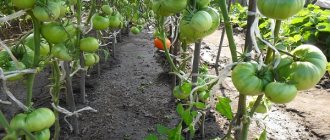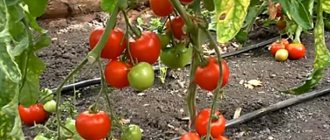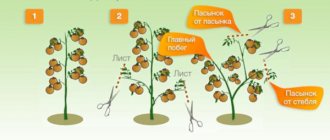Description of Walford Miracle tomatoes
A light-loving plant of indeterminate type rises up to 2 m, and even higher in nutritious soil. The stem is weak for large-fruited tomatoes and requires tying each cluster to the trellis. For greater yield and uniform distribution of ovaries, the Walford Miracle variety is grown in 2 trunks. Tomato leaves are small and not dense. The first flower clusters are formed after 6-7 leaves. 5-14 buds are formed on the inflorescences.
In a greenhouse, the Walford Miracle bush forms up to 8-9 fruit clusters. And in open ground, the variety grows lower, up to 1.6 m, and produces 4-6 complex inflorescences. To ensure large fruits, leave no more than 5 ovaries on one cluster. The fruits ripen 115-118 days after the sprouts appear.
The fruits of the American selection with the promising name Miracle grow quite large, from 6-10 cm in diameter. The tomatoes form a so-called heart shape and are moderately ribbed. There are options: sometimes tomatoes are too elongated, sometimes two fused flowers form a boat silhouette in a longitudinal section. The weight of tomatoes ranges from 170-200 g – the smallest ones, to 600-700 g, which can be obtained with good care. On average, the weight of the fruit of the variety bred by farmer M. Walford is 270-360 g. The color of the dense skin and pulp is pink, turning into intense crimson. The tomatoes are juicy, fleshy, the seed chambers are small and sparse, and there are few seeds.
Attention! With good care, the variety is high-yielding and pleases with large fruits. Tolerant during periods of changes in night and day temperatures.
Features of cultivation
Seeds for seedlings are traditionally planted in early March, that is, 2 months before the planned transplant into a greenhouse or garden bed. Since the Wolfdord Miracle tomato prefers fertile soil, it is better to use a mixture of turf soil with humus and compost in a ratio of 2:1:1. You can also purchase soil in the store. The mixture is pre-conditioned in the oven (15 minutes, 130 degrees) or poured with a weak solution of potassium permanganate.
Walford Miracle tomato seeds are kept in a growth stimulant solution before planting. Then they are planted in peat pots (to avoid diving) to a fairly large depth (2-3 cm). Sprinkle with earth, water, cover with film with holes and put in a warm place. Initially grown at a temperature of 24-25 degrees and additional lighting for 12-14 hours. After 10-15 days, the indicators are reduced to room temperature, and a week before transplantation they are hardened at 16-18 degrees.
The maximum yield can be harvested when growing the Walford Miracle tomato in a greenhouse
Miracle Walford tomato seedlings are transferred to open ground in early May. They can be planted at a distance of 50 cm, and left 60 cm between rows. Standard care - watering 1-2 times a week, fertilizing 2 times a month (complex mineral fertilizer alternating with organic matter). The soil is mulched and periodically loosened. Be sure to weed. Remove the side shoots and form a bush with 2 stems. As soon as the tomato grows to 1 m in height, it is tied to a support.
Pros and cons of the Walford Miracle tomato variety
Although growing Walford Miracle tomatoes involves fulfilling mandatory care requirements, the variety is attractive to gardeners for its striking advantages:
- average ripening period - early or mid-August;
- long fruiting, up to frost;
- large fruit;
- high gastronomic assessment;
- stable yield.
The disadvantages of the characteristics of the salad tomato variety include:
- the need to garter the brushes and stems;
- providing plants with a highly nutritious substrate.
Detailed description
The Walford miracle was bred by selectively crossing several dozen species of tomatoes in the United States. The Miracle hybrid was created by American experimenter and farmer from Oklahoma Max Walford. The variety is spreading throughout the world after a farmer wins a tomato competition. The import of seeds to Russia began in 2005. The variety grows well in greenhouse conditions. Tomatoes are allowed to be grown throughout the country in special comfortable conditions.
The hybrid variety for annual cultivation took only the best qualities from its relatives. The Miracle tomato is a mid-season variety, the stem of which in greenhouse conditions reaches 1.7-2 m. When grown in open ground, the growth of tomatoes stops at the first night frost. The leaves of the tomato are medium in size, slightly corrugated, slightly pubescent with villi on the back side. The foliage color is green or dark green.
The stem requires garter, thickened and flexible towards the base. Bushes must be formed, since the variety belongs to indeterminate tomatoes. The inflorescence is simple and comes in pale yellow and bright yellow shades. The flowers are arranged in small groups of 3-4 flowers on the stalk. The growing season depends on the region of planting and the time of planting seedlings in the ground. The peduncle is articulated, making harvesting easier.
Advice! It is necessary to trim the tops of the bushes to prevent the formation of a small crop.
Description and taste of fruits
Tomato fruits are always large in size, with a heart-shaped shape characteristic of the Walford variety. The tomatoes are slightly ribbed and dense. Unripe fruits are light green in color and have a dark spot at the base of the stalk; ripe fruits are bright red or scarlet. When cut, the pulp is fleshy, pinkish in color, with 4-5 cavities.
The skin of the fruit is dense and elastic, crunchy when tasting. The Walford Miracle tomatoes taste juicy and sweetish. The peel has a slight sour aftertaste, although the composition contains sugar up to 6.5%. Beautiful fruits with a glossy sheen are located on the bushes in alternate clusters of 2-3 tomatoes. Juicy tomatoes reach 8-10 cm in diameter. Average weight varies from 250 to 350 g.
Walford Miracle fruits are grown commercially in greenhouse conditions. Miracle tomatoes contain:
- lycopene, which improves digestion;
- pectin normalizes blood pressure;
- the glycoalkaloid contained in the juice of squeezed tomatoes has bactericidal properties;
- serotonin acts as a natural antidepressant.
Miracle tomato seed powder is used as an additional component of sedative tablets. For human health, Walford tomatoes are best consumed stewed or raw. Many vegetable growers praise this variety for preserving its taste when preserved. After heat treatment, all nutritional minerals retain their usefulness. Due to their unusual sweetish aftertaste, tomatoes have received a wide range of applications in gourmet culinary dishes. Walford Miracle tomatoes are often used to obtain juices and sauces. They are especially good in lecho and baked form.
Agricultural technology of tomatoes Miracle of Walford
Tall, large-fruited tomatoes with a delicate taste are grown using conventional methods, sowing seeds for seedlings. In the southern regions they are also planted in holes in open soil enriched with fertilizers.
Warning! Seeds of the rare variety Wolford's Wonder (Walford's Wonder) are purchased mainly in online stores.
Growing seedlings
In order to plant the Walford Miracle variety in a greenhouse by the beginning of May, the seeds are sown in the last ten days of February or early March. For planting in open ground, sowing is carried out at the end of March, beginning of April, which depends on the region. Untreated seeds are soaked in potassium permanganate and then treated with a growth stimulator according to the instructions. It is better to plant a rare variety in peat tablets, placing the container in a warm place above 21 °C. Seeds germinate in 6-7 days. Sprouts in heat can quickly stretch and die, so they are provided with bright light, but not high temperature, up to 18-20 °C. After 6-7 days, the tomatoes are provided with comfortable heat at 23-27 °C and light for 14 hours.
At the 3rd week of growth, the tomatoes are transplanted into pots with a nutrient substrate. Seedlings are fed with complex fertilizers for seedlings at the age of 20-25 days. Support is repeated after 2 weeks. Water so that the substrate is slightly moist and does not dry out.
Landing rules
After 45-50 days, the Walford Miracle seedlings develop up to 6-7 leaves and the first inflorescence begins to form. Those tomatoes that will grow in the garden begin to harden by taking them out into the air. With a growth of 30-35 cm, plants pass:
- planting pattern 50x50 cm;
- the holes are watered with 1.7-2.1 liters of water;
- nitrogen fertilizer is added to the wells;
- transfer, keeping the earthen lump intact.
- After planting, the soil is compacted and mulched to retain moisture.
Watering and fertilizing
In a greenhouse, tomatoes are watered every 2-4 days, and in open ground - depending on precipitation, so that the soil is moderately moist, but not constantly wet. Warm water, infused under the sun or in a greenhouse. It is poured near the plant; in wet weather, sprinkling is not carried out. Up to 7 liters of water are spent on an adult bush to moisten all the small roots. After watering, Miracle Walford tomatoes are fed. In the first half of development, organic fertilizers are used - solutions:
- from mullein;
- bird droppings;
- green mass.
Important! During the fruit filling phase, it is better to use balanced complex preparations that contain the potassium and superphosphate necessary for this period.
Pinching and tying
16-18 days after transplantation, regular pinching of Walford's Miracle tomatoes begins: the shoots that form in the leaf axils are broken off. It is recommended to remove stepsons that have grown more than 4-6 cm. At the same time, the bushes are tied to supports or trellises.
Formation
When pinching, all the shoots that are located under the first brush are broken off. Choose a strong stepson to form the second trunk. As the fruits fill, cut off all the lower leaves. The brushes are also formed, leaving 1-4 ovaries if you want to get large fruits. In August, the tops of the trunks are pinched, stopping the growth of the bush. Also, in the second or third ten days of August, the leaves on the Walford Miracle tomato bush are torn off, leaving only the top ones.
Protection from diseases and pests
The Walford Miracle variety is resistant to most fungal diseases, including root rot and powdery mildew. The plant may suffer from late blight, gray rot or viruses that cause infections. If there are signs of viral diseases, the bushes are removed, since the diseases are incurable. Preventively protect against pests:
- Colorado potato beetles are removed from a rare variety by hand;
- the whitefly does not start in the greenhouse if the requirements of agricultural technology are met;
- aphids retreat when sprayed with a soapy solution from a spray bottle.
Advantages and disadvantages of the variety
The main advantage of Walford's Miracle tomatoes is their consistently high yield and pleasant sweet taste. The hybrid is resistant not only to a number of diseases, but also to weather conditions. If you grow plants in a greenhouse, care really won’t seem difficult.
Walford's Miracle tomatoes fully ripen on the bush
pros
- good yield;
- balanced sweet taste of tomatoes;
- both seedlings and bushes can withstand temperature changes;
- resistance to a number of Solanaceae diseases;
- the fruits are quite large, with an attractive presentation;
- Even during transportation, tomatoes do not burst;
- tomatoes ripen both on the bush and in a dark place.
Minuses
- bushes need to be pruned and tied up;
- the first fruits may turn out to be sour (but some summer residents value just such tomatoes);
- large tomatoes are not suitable for whole-fruit canning;
- Seeds need to be constantly purchased - collecting them yourself is impractical.
General characteristics of the variety
The Walford Miracle tomato variety is an indeterminate tomato. Plants reach 1.7-2 m when grown in a greenhouse. In open ground, tomato growth stops with the onset of cool nights and reaches about 1.5 m.
In terms of ripening period, Walford's Miracle is a mid-season variety. It takes 115-130 days from sowing to harvesting the first tomatoes. In central Russia, ripened fruits can only be obtained in mid-August. Most of the crop will have to be harvested unripe. When cultivated in a greenhouse, the growing season lasts a little longer, and the gardener will be able to get more ripe tomatoes.
Walford's Miracle tomato bushes are distinguished by low foliage of the stem. This eliminates the unnecessary work of removing part of the green mass. Plants need to be pinched, as the bushes branch well. To increase productivity, the bush is formed into 2 stems.
The description of the Walford Miracle tomato notes its main drawback - its thin stem. Because of this, the seedlings look elongated and weak, but when transplanted, they quickly begin to grow and soon form a flower cluster (above 6-8 leaves). To prevent young plants from being broken by the wind in open ground, they need to be tied up immediately after transplanting. Subsequently, a garter is placed under each inflorescence to prevent the stem from breaking off as the fruit grows.
The yield of the variety may vary depending on the location of the site and weather conditions. When planted on fertile soil rich in organic matter in a sunny, dry summer, it is possible to harvest up to 7-8 kg of tomatoes from 1 bush. The same results can be achieved in a greenhouse. But in a damp and cold summer, Walford's Miracle may not live up to the gardener's expectations.










